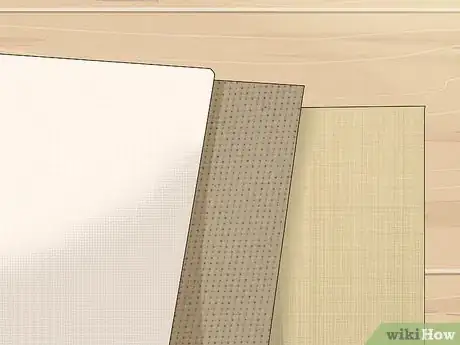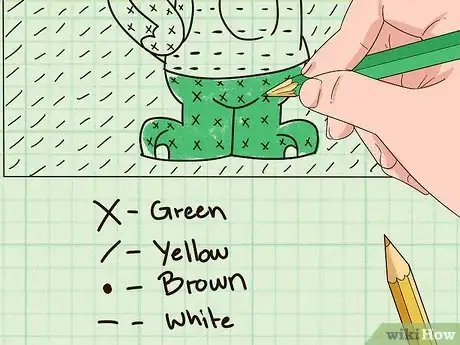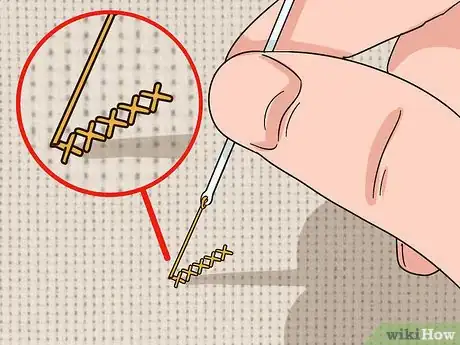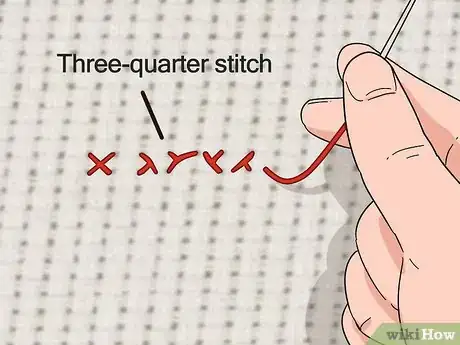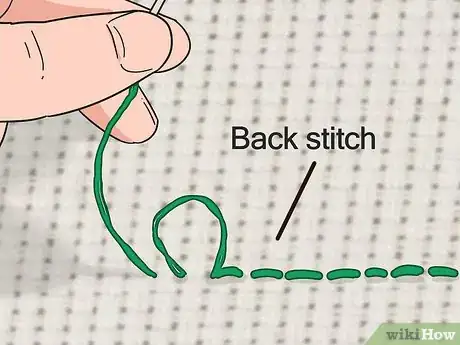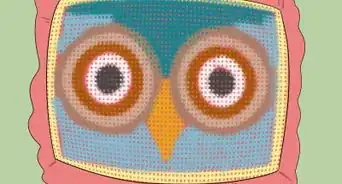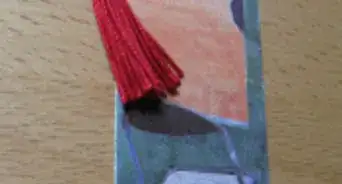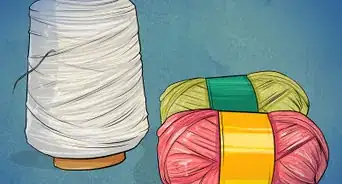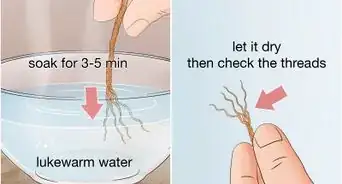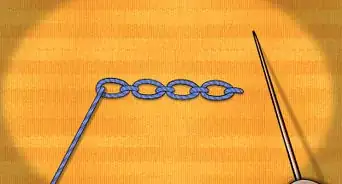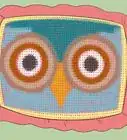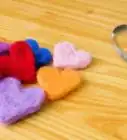wikiHow is a “wiki,” similar to Wikipedia, which means that many of our articles are co-written by multiple authors. To create this article, 60 people, some anonymous, worked to edit and improve it over time.
This article has been viewed 799,575 times.
Learn more...
Taking up needle point? If so, one of the stitches you'll need to learn is the cross stitch. This ancient, cross-cultural embroidery technique is also known as counted cross-stitch. The pictures below will show the method as worked on a plastic canvas with yarn to help you easily identify the technique.
Steps
Selecting Your Materials
-
1Choose your fabric. Although cross stitch refers to the way in which you create a stitched pattern and not to a particular fabric, it is most often done on a type of material known as Aida cloth. This material is loosely woven in a grid pattern that makes lining up all your stitches easy. Aida fabric comes in different sizes which refer to the number of stitches that can be created in 1 square inch. The options are typically 11, 14, 18, and 28.
- It is easiest to start on an Aida cloth that uses an 11 or 14 stitch count, as this provides larger spaces for your cross stitch. The higher the number of stitches, the smaller your crosses will be.
- If you don't want to use Aida cloth for your cross stitch, other popular options are linen or fiddlers cloth. Both these lack the same wide spaces Aida cloth provides for beginners though.
-
2Select your thread. Cross stitch is great because it offers so much freedom on the part of the maker, particularly in the color options of the thread. Embroidery floss is typically used and can be found in hundreds of colors.
- Each skein of embroidery floss comes in six threads, but only 1-3 will be used for cross stitch at a time.
- Embroidery floss comes in both matte colors as well as iridescent and metallic. The latter two are a bit more difficult to work with and cost several times more than the former.
- If you have a difficult time doing cross stitch with your thread, you can get waxed thread or use a bit of beeswax to prep your thread before starting your stitching. It will help the floss to the thread and tie off easier.[1]
Advertisement -
3Choose a pattern. Cross stitching is as simple as matching the grid on a pattern of choice to the grid in your cross-stitch fabric. Choose a pattern from a booklet or online, and gather embroidery floss in colors to match.
- As a beginner, it may be best to start with a simple cross stitch. Find a pattern that is small and doesn’t involve too many details and uses a total of 3-7 colors only.
- You can create your own pattern using your own images and a computer program or a bit of graph paper if you don't like the patterns that are available.
-
4Get an embroidery hoop. This is a double ring made of plastic, metal, or wood that secures your cross stitch as you work. Although you can create a cross stitch without one, embroidery hoops are incredibly helpful and relatively inexpensive. Small hoops are easier to hold but must be moved often, while large hoops require more of a grip but need to be moved around your needlepoint less.
Making Your Own Pattern
-
1Choose an image. Any image can be created into a cross stitch pattern, but simple ones with easily definable shapes are best. Choose a picture or drawing that has only a few colors and lacks a lot of detail.
-
2Adjust your image. You may want to crop and enlarge your image so that you focus on only a single portion of the original picture. If you have a photo editing program, use a "posterize" feature to transform your picture into easily definable shapes. Convert your picture to grayscale before printing so that choosing colors to match the values is easier.
-
3Trace your image. Print a physical copy of your image and gather a piece of graph paper. Lay the graph paper over the top of your printed image and trace the outline of the most basic shapes. Try to limit the amount of detail that you copy over.
-
4Choose your colors. With your image and shapes traced, choose 3-7 colors to use for your cross stitch. Use colored pencils that match your chosen colors to shade in the shapes, focusing on a grid pattern and avoiding curved lines.[2]
-
5Use a computer program. If drawing your own pattern by hand isn't your deal, try using an easy computer program to convert your favorite image to a cross stitch pattern. Programs such as "Pic 2 Pat" allow you to choose the size of the pattern, number of colors, and amount of detail included in your finished pattern.[3]
Doing a Basic Cross Stitch
-
1Cut your fabric and floss. The size of your fabric will depend on the size of the pattern you are using. Each small square on the cross stitch fabric is representational of a single stitch (or ‘x’ shaped cross), and can be counted across to get your exact size. Your embroidery floss should be cut to a length of about 36” to begin.
- Embroidery floss comes in strands of six threads, but typically only one is necessary for cross stitching. Gently pull apart the groupings of threads from the center and use a single thread for each section on your pattern.
- Some patterns may call for multiple threads to be used at once, so make sure to check yours before assuming the use of a single thread.
- If you run out of thread for your pattern, don’t fear! One of the great things about cross stitching is that you can’t tell where you start/stop from the front. Simply cut additional thread and start again from where you left off.
-
2Thread your needle. Take your single thread of embroidery floss and create a loop at the end. Wet the center of this loop (by licking it or using a drop of water) to make threading it easier. Then pull the loop through, leaving the two tail ends (one should be very short) to hang out the opposite side of the eye of the needle.
-
3Begin your cross stitch. Count on your pattern the number of grid spaces to the first stitch (typically the centermost stitch), and insert your needle from the bottom. Pull the thread all the way through, leaving a bit of the loop at the bottom. Then, cross the thread down or up diagonally and pull the needle through the loop underneath to create a stable anchor for your stitching.
- It doesn’t matter if you start your cross stitch going ‘////’ or ‘\\\\’ as long as you are consistent with this pattern over the entirety of your project.
- With every stitch you make, thread your strings over the loose tail in the back to secure it to your cross stitch fabric. This will also make it less likely for your cross stitch to unravel from being tugged or pulled.
-
4Continue stitching. Using the same ‘x’ stitch pattern, work outwards from the center of your cross stitch until you have completed the pattern. If you run out of thread at any point, tie the floss off in a knot at the back and cut a new piece.
-
5Finish your piece. When you have completed the pattern and added an optional backstitch border, tie off your thread underneath your cross stitch. Tie a simple knot on the backside of your pattern, and cut off any remaining thread.
-
6Wash your cross stitch. Hands are naturally very dirty and oily, and as such make the fabric of your needlepoint dirty as well. Frequent hand washing cans help to limit the amount of grime that is transferred to your fabric, but a ring of dirt around your embroidery hoop is nearly inevitable. Gently hand wash your cross stitch with soap and water and allow to air dry when you are finished with it.
Practicing More Advanced Cross Stitch Techniques
-
1Create a quarter stitch. Quarter stitches are, as they sound, 1/4 of a completed 'X' shape in a cross stitch. These can be used to add subtly curved lines and lots of detail. To Create a 1/4 stitch, bring your needle from the corner of one of the boxes through the center of the box. This should create a single leg of the "X" shape.
-
2Make a three-quarter stitch. This stitch is another commonly used stitch for creating detail in your pattern. It is made by doing a half stitch (a complete diagonal stitch) and a quarter stitch. The appearance is of an "X" with only three legs instead of four.
-
3Create a back stitch. To create a solid border around your cross stitched figures, use a single strand of embroidery floss (black is usually used) and back stitch around the outline of your pattern. To create a back stitch, work vertically and horizontally (rather than creating ‘/’ or ‘\’ shaped stitches, form ‘|’ or ‘_’ shaped stitches) around your figure. Pull the needle up at the top of a box, and then back through at the bottom, repeating this pattern until you have completed the border.
-
4Do a French knot. Although this is not a traditional cross stitch, it can be used to create small dots or spots on your needle point. To create a French knot, pull your thread up through your fabric. Wrap your needle around the thread 2-3 times near the base of the entrance of the thread. Insert the needle back down into the fabric near the origin, holding the thread taut as you do so. Pull the needle all the way through to complete the French knot.[4]
Community Q&A
-
QuestionHow can I clean my finished cross-stitch? It's a little dirty.
 wikiHow Staff EditorThis answer was written by one of our trained team of researchers who validated it for accuracy and comprehensiveness.
wikiHow Staff EditorThis answer was written by one of our trained team of researchers who validated it for accuracy and comprehensiveness.
Staff Answer wikiHow Staff EditorStaff AnswerFill a bowl with cold water. Dip the cross-stitch in and clean with a gentle soap. Rinse well. To dry, place it face down on a clean towel that has been doubled over on a flat bench or area. Iron to help it dry faster, especially if the room temperature is cold. It should look nice and clean, and will be ready to frame or use as needed.
wikiHow Staff EditorStaff AnswerFill a bowl with cold water. Dip the cross-stitch in and clean with a gentle soap. Rinse well. To dry, place it face down on a clean towel that has been doubled over on a flat bench or area. Iron to help it dry faster, especially if the room temperature is cold. It should look nice and clean, and will be ready to frame or use as needed. -
QuestionWhat is evenweave?
 wikiHow Staff EditorThis answer was written by one of our trained team of researchers who validated it for accuracy and comprehensiveness.
wikiHow Staff EditorThis answer was written by one of our trained team of researchers who validated it for accuracy and comprehensiveness.
Staff Answer wikiHow Staff EditorStaff AnswerEavenweave refers to the fabric used for embroidery that has the same number of threads per inch both horizontally and vertically. The evenweave allows you to create even cross stitches throughout the whole project.
wikiHow Staff EditorStaff AnswerEavenweave refers to the fabric used for embroidery that has the same number of threads per inch both horizontally and vertically. The evenweave allows you to create even cross stitches throughout the whole project. -
QuestionHow do I do a French knot?
 wikiHow Staff EditorThis answer was written by one of our trained team of researchers who validated it for accuracy and comprehensiveness.
wikiHow Staff EditorThis answer was written by one of our trained team of researchers who validated it for accuracy and comprehensiveness.
Staff Answer wikiHow Staff EditorStaff AnswerIt is easiest to see full instructions with images––read How to Do a French Knot for guidance.
wikiHow Staff EditorStaff AnswerIt is easiest to see full instructions with images––read How to Do a French Knot for guidance.
Warnings
- Don't hurt yourself with the needle.⧼thumbs_response⧽
References
About This Article
To cross stitch, cut your fabric to the appropriate size, and your floss colors to length of about 36 inches. Take a single thread of embroidery floss, and thread it through the needle. Begin the cross stitch in the centermost block, pushing the needle through the back of the fabric. Continue cross stitching with 1 “x” per grid block on the pattern. To finish the cross stitch, tie off and cut the thread, and wash the cloth to remove oils from your hands. For more tips, including how to do more advance stitches, scroll down!
